here - Pima County Food Alliance
advertisement
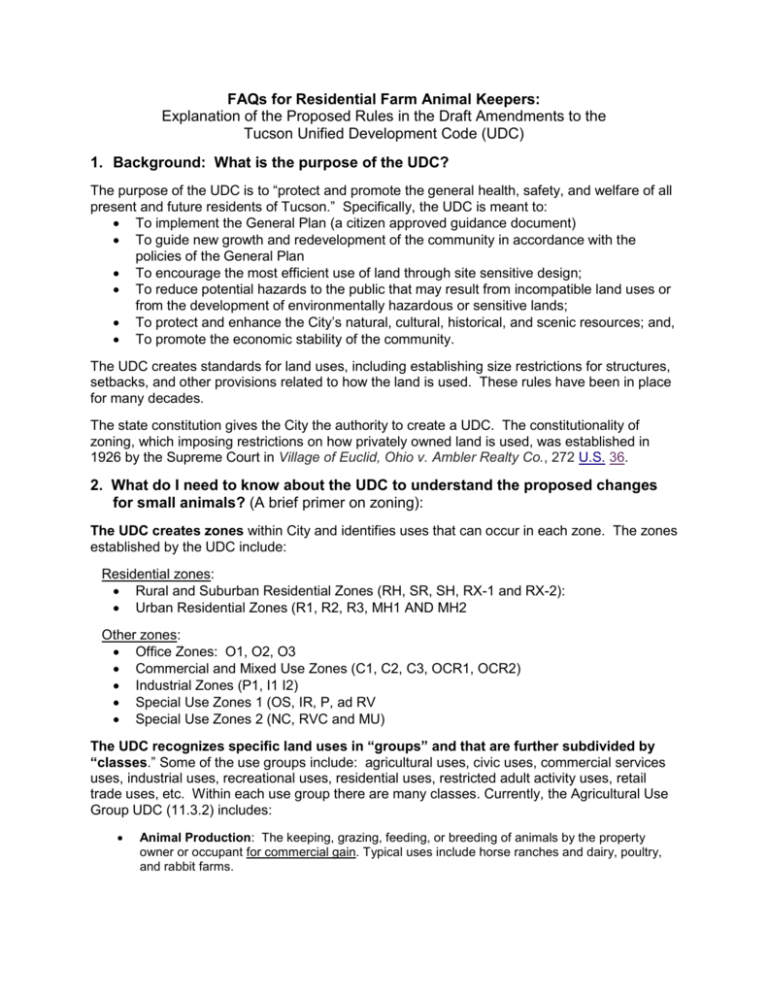
FAQs for Residential Farm Animal Keepers: Explanation of the Proposed Rules in the Draft Amendments to the Tucson Unified Development Code (UDC) 1. Background: What is the purpose of the UDC? The purpose of the UDC is to “protect and promote the general health, safety, and welfare of all present and future residents of Tucson.” Specifically, the UDC is meant to: To implement the General Plan (a citizen approved guidance document) To guide new growth and redevelopment of the community in accordance with the policies of the General Plan To encourage the most efficient use of land through site sensitive design; To reduce potential hazards to the public that may result from incompatible land uses or from the development of environmentally hazardous or sensitive lands; To protect and enhance the City’s natural, cultural, historical, and scenic resources; and, To promote the economic stability of the community. The UDC creates standards for land uses, including establishing size restrictions for structures, setbacks, and other provisions related to how the land is used. These rules have been in place for many decades. The state constitution gives the City the authority to create a UDC. The constitutionality of zoning, which imposing restrictions on how privately owned land is used, was established in 1926 by the Supreme Court in Village of Euclid, Ohio v. Ambler Realty Co., 272 U.S. 36. 2. What do I need to know about the UDC to understand the proposed changes for small animals? (A brief primer on zoning): The UDC creates zones within City and identifies uses that can occur in each zone. The zones established by the UDC include: Residential zones: Rural and Suburban Residential Zones (RH, SR, SH, RX-1 and RX-2): Urban Residential Zones (R1, R2, R3, MH1 AND MH2 Other zones: Office Zones: O1, O2, O3 Commercial and Mixed Use Zones (C1, C2, C3, OCR1, OCR2) Industrial Zones (P1, I1 I2) Special Use Zones 1 (OS, IR, P, ad RV Special Use Zones 2 (NC, RVC and MU) The UDC recognizes specific land uses in “groups” and that are further subdivided by “classes.” Some of the use groups include: agricultural uses, civic uses, commercial services uses, industrial uses, recreational uses, residential uses, restricted adult activity uses, retail trade uses, etc. Within each use group there are many classes. Currently, the Agricultural Use Group UDC (11.3.2) includes: Animal Production: The keeping, grazing, feeding, or breeding of animals by the property owner or occupant for commercial gain. Typical uses include horse ranches and dairy, poultry, and rabbit farms. Crop Production: The growing and harvesting of agricultural products to provide food, fiber, or horticultural vegetation for ornamental purposes, or any combination of these uses. Typical uses include the growing of field crops, fruit and nut orchards, nurseries, and greenhouse operations. General Farming: Any combination of Animal and Crop Production limited to personal use. Stockyard Operation: The temporary confinement of livestock in conjunction with their transport, fattening, or auctioning on a wholesale or retail basis. Typical uses include feedlots and cattle pens. The UDC specifies what specific land use classes are permitted in each zone. There are different types of uses, including: Permitted use (also referred to as principal use): is the main use to which the premises is devoted and the primary purpose for which the premises exist. Special exception use: typically a principal use that is not allowed by right within a zone, but is permitted if approved through a particular review procedure. Accessory use: is a use that is incidental to a principal use and may be necessary for the operation of the principal use. Temporary use: uses that are needed or are in place for only short periods of time Many different uses are permitted in each zone – land use is not limited by the name of the zone. I addition to residential uses, the UDC may currently permit civic uses, commercial service uses, recreation uses, utility uses, or others in residential zones, depending on the specific zone. Residencies are permitted in many zones, not just those designated as residential zones, and accessory uses in each zone can cover a wide range of activity. Urban residential zones, are among the most restrictive in terms of the land uses that are permitted. That’s because when people live in close proximity to each other, the activity on one lot is more likely to impact the people who live on the lot next door. Enforcement of the UDC is done on a complaint basis. Many people have been keeping animals in a manner that does not comply with the current code. Unless someone complains, the City will not enforce the code. If you get along with your neighbors you probably have nothing to worry about. However, if your relationship with your neighbor is not friendly, you can be reported and lose your animals. 2. What does the UDC currently say about keeping household chickens and other small animals for food purposes? No agricultural uses that include animals are identified as a permitted use in urban residential zones or in many of the other zones where people live. However, the current Zoning Administrator allows keeping small animals as an accessory use to a residential use. The rationale is that keeping chickens is something that is part of routine residential activity and therefore can be an accessory use to a family residence. Other aspects of the current code are still being enforced. The current UDC requires a 50’ setback for coops and shelters (and other types of buildings) in zones where animals are permitted. Most lots in urban residential zones are not wide enough to accommodate a 50’ setback from all property lines. Many people have placed their coops closer than 50’, sometimes as close as on the property line. The zoning officials have permitted small coops (less than 5 ft high and 10 sq ft in area) on the property line using a “dog house exemption” that has been used for many years. For larger coops the setback from the property line in the proposed rules will be 2/3 of the height of the coop, but no closer than 6’. 4. What other rules apply to keeping small farm animals in Tucson? The UDC deals with land use only. Other City rules that apply to animals appear in the Tucson City Code. The City Code is organized hierarchically by Chapter, Article, and Section. Chapter 4 is dedicated to Animals and Fowl. Articles I-III contain rules for all animals and include sections related to animal cruelty and neglect, vicious or destructive animals, animal or fowl fighting, harboring lost animals and other topics. These rules apply to chickens and other small farm animals. Article IV of Chapter 4 relates specifically to Fowl. It places a limit of 24 fowl on any property within the city as long as all other codes (such as the UDC) are followed (Sec. 4-56; emphasis added). Other sections of Chapter 4/Article IV include prohibiting fowl from running at large, keeping coops clean and sanitary, prohibiting male fowl (roosters included), and rules about keeping pigeons. There are penalties for disregarding these rules. Chapter 16 of the Tucson City Code relates to Neighborhood Preservation. The purpose of Chapter 16 is “to promote and preserve the health, safety and welfare of the citizens… and to protect residents and neighborhoods against hazardous, blighting and deteriorating influences or conditions that diminish quality of life and contribute to the downgrading of neighborhood property values.” (Sec.16-2). Article IV of Chapter 16 describes “unlawful acts.” Those that might be related to keeping small farm animals include excessive noise (Sec. 16-31) and public nuisance, described as “anything that is injurious to health, or is indecent or offensive to the senses, or is an obstruction to the free use of property, so as to interfere with the comfortable enjoyment of life or property by an entire community or neighborhood, or by any considerable number of persons, is hereby declared to be a public nuisance” (Sec. 16-34). 5. Why do backyard food producers need new animal rules in the UDC? Currently, if you live in a zone where agricultural uses are not permitted, you can have chickens and other small animals only because the current Zoning Administrator has decided to stretch the definition of residential activity. He also is waiving the coop setback of 50’ for small coops (less than 10 sq ft) using the “dog house exemption.” There is no guarantee that a future Zoning Administrator will continue to permit these activities. If someone complains about your animals, the law is on their side, not yours. Unless you have a 50’ setback you can lose your animals if someone complains. Several people have lost their animals in the past year. 6. Where do the new rules apply? These are rules for small farm animals kept in urban areas within the City of Tucson. If you live in a zone that already permits agricultural activity (RX1, SR, SH, RH, MU, IR, C2 or C3), the proposed rules for urban animals will not apply to you. Since agricultural activity is already permitted in these zones, the existing agricultural rules will continue to apply. If you live in any other zone, the proposed urban agriculture rules will apply. 7. What kind of animals are we talking about? “Small Farm Animals” are defined in the draft UDC amendments as “animals such as miniature goats, rabbits, rodents, fowl such as chickens, ducks, geese and turkeys, and other similar small food-producing animals” (The rules do not apply to dogs, cats, pigeons, other nonproducing fowl, fish, rabbits, rodents and invertebrates such as worms. Small farm animals are the focus on the proposed UDC amendments. Larger animals, like cows, hogs, and horses, are considered to be part of “animal production” an agricultural activity that is defined as the keeping, grazing, feeding, or breeding of animals by the property owner or occupant for commercial gain. Typical uses include horse ranches and dairy, poultry, and rabbit farms.” Animal production rules will not change – animal production is currently a permitted activity in outlying areas, including some of the suburban and rural residential zones, but not in urban residential areas. Keeping small farm animals will be permitted as an accessory use to any permitted residential use in a residential or nonresidential zone. That means chickens and other small animals that are raised for food production may be kept wherever people live in Tucson. However, other rules do apply that limit the number of animals permitted and placement of their shelters. 8. What animals will be prohibited? Roosters are not permitted under the current rules, and will not be permitted under the new rules either. Un-castrated male miniature goats over 5 months old are not mentioned in the current code, but will be prohibited in the new code. 9. How many animals can I have under the proposed urban agriculture rules? In order to provide the most flexibility for people raising small animals for food purposes, the proposed code utilizes an “animal unit” approach, which assigns unit numbers to various types of animals and then defines the number of units permitted, based on lot size. The units assigned to each type of animals are based on a rough estimate of the amount of nuisance waste, noise, odor, etc. - they will create. Table 1: Assignment of Animal Units If you have written consent from the adjoining property owners, you may exceed the limits outlined below. Table 1 shows the number of units assigned to each small animal. Miniature goats should be kept in pairs so you will need at least 10 Animal Units to be able to keep them. The maximum number of units that will be permitted is based on the size of the lot. Two units per 1000 square feet will be permitted, but there will be a cap. Table 2 describes the way the cap will be applied. Instructions on how to find the square footage of your property are provided in Appendix 1. Type of Animal # Units Chicken Duck Turkey or Goose Miniatrue Goat 1 2 4 5 Table 2: Animal Unit Caps Lot size <16,000 sq ft 16,000-143,999 sq ft 144,000 or more Cap 24 units 36 units 48 units To find out how many animal units you can have, divide the total square footage of your lot by 1000 and then multiply by 2. Table 3 shows how the calculation works. Table 3: Examples for Calculating Permitted Animal Units Lot size 5,600 sq ft 7,300 sq ft 9,400 sq ft 12,000 sq ft 14,500 sq ft 44,000 sq ft Divide by 1000 Multiply times 2 Animal Units 5.6 7.3 9.4 12 14.5 44 11.2 14.6 18.8 24 29 88 11 15 18.8 24 29 88 Animal units permitted 11 15 19 24 24 (cap reached) 36 (cap reached) Once you know how many Animal Units you can have, the number and type of animals you keep is your decision. Table 4 provides some examples: Table 4: Examples of Animal Mix by Number of Animal Units Permitted Units permitted Scenario 1 Scenario 2 11 11 chickens 2 miniature goats 1 chicken 15 15 chickens 2 miniature goats 5 chickens 19 19 chickens 2 miniature goats 9 chickens 24 24 chickens 4 miniature goats 4 chickens 36 36 chickens 6 miniature goats 6 chickens Scenario 3 1 ducks 2 turkeys 1 chicken 2 ducks 2 turkeys 3 chickens 4 ducks 1 turkey 7 chickens 6 ducks 2 turkeys 4 chickens 6 ducks 2 turkeys 6 chickens 2 miniature goats Scenario 4 3 turkeys 5 chickens 4 turkeys 4 chickens 11 chickens 2 turkeys 20 chickens 2 ducks 20 chickens 2 miniature goats 3 ducks 10. What will the rules about animal shelters be? The current UDC regulates all accessory buildings – including sheds, garages, animal enclosures and any other type of structure you place on your property. The UDC amendments relate to animal enclosures only. The existing rules will still apply to other types of structures. The amendments differentiate between small and large animal shelters in some aspects, but not all. Table 5 summarizes the rules for each. Table 5: Proposed Rules for Small and Large Animal Enclosures Small ≤ 6’ high and 16 sq ft in area Placement Setbacks Side and back yards only Large >6’ high and and/or >16 sq ft in area Side and back yards only. 20 ft from a neighboring residence A distance 2/3 of the height of the pen but at least 6 ft. 20 ft from a neighboring residence Height restrictions Area restrictions Construction 6 ft 16 sq ft. Secure, sturdy with a roof to protect animals from predators. When the property s 36,000 sq ft or more, the setback must be 50’ from all property lies. None required from property lines that abut an alley or other right of way, or when adjacent to a non-residential use. 12 ft None specified Secure, sturdy with a roof to protect animals from predators. 11. What if my existing coop/shelter does not meet these requirements? Coops and shelters were in existence prior to the adoption of these UDC amendments can receive an exemption. To can receive an exemption if you: 1. Provide a site plan 2. Have no violations on record related to your structure 3. Prove that your structure was there before the new rules are adopted. You can do this by providing an aerial photo or other proof. 4. There are no enforcement violations related to the structure for the past 5 years submitted by a property owner within 300 ft of your property 5. Your structure meets the safety requirements for animal shelters
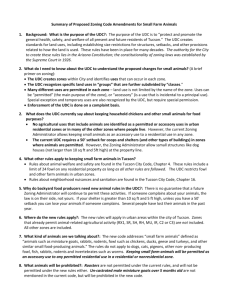

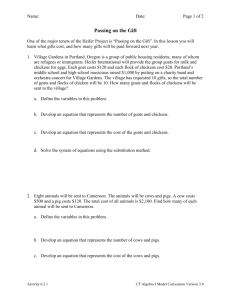
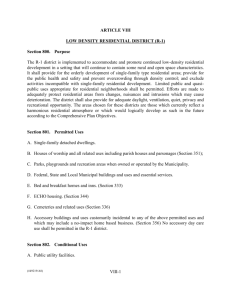
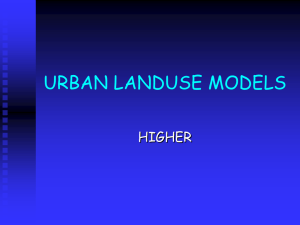
![Newsletter 26.04.13[1]](http://s3.studylib.net/store/data/006782410_1-da9f3895022a2272f47db633b66536f9-300x300.png)

